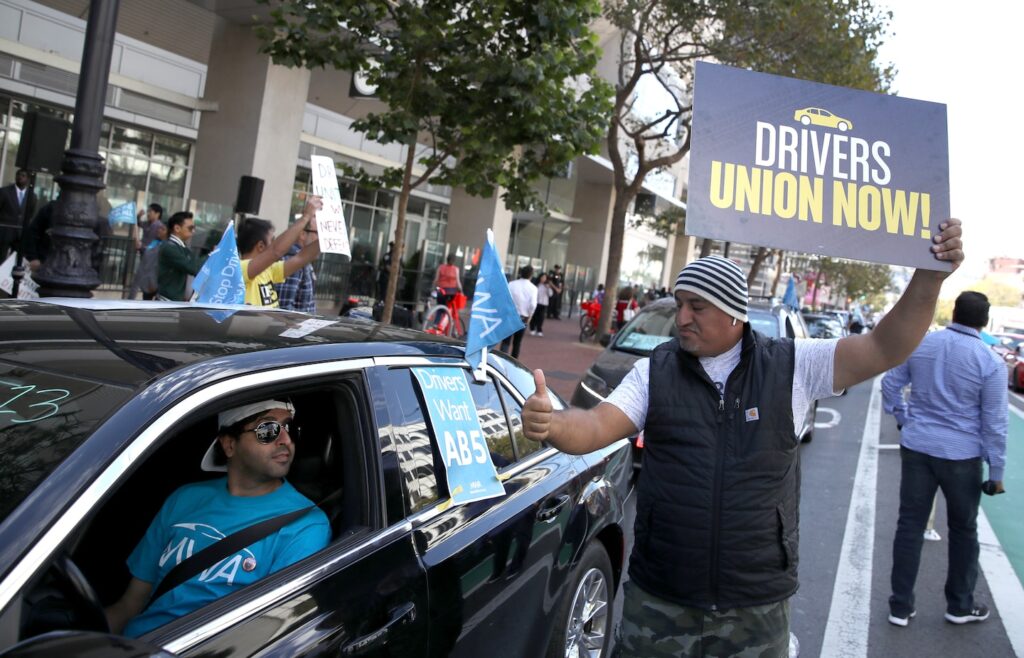Drivers say that Uber and Lyft are taking an increasingly large cut out of fares, forcing drivers to work longer hours to make ends meet. They are demanding a living wage that ensures drivers aren’t living in poverty, and transparency over how pay is calculated. They also want to end unfair deactivations — when a driver loses access to the platform, among other things.
“The main challenge is surviving,” said Nupur Chowdhury, an Uber driver and ride-share organizer in Arlington who helped plan the strike in the Washington area. “We cannot make the same amount of money we used to make, even if we work double the hours.”
The groups are also demanding improvements to safety features for drivers, amid a spate of carjackings and other attacks on Uber and Lyft drivers, especially in the Washington area.
Both Uber and Lyft said similar protests and strikes have never had any substantial impact on driver availability or trips in the past.
Platform workers will be rallying outside airports around the country and Uber’s offices on Wednesday. App-based food delivery couriers will also be striking over pay in the United Kingdom on Wednesday.
Organizers say declining pay for drivers in recent years amid high inflation led to spontaneous strikes last year at airports in cities including San Diego, Atlanta, and Minneapolis. Those small strikes galvanized workers around the country to organize the Valentine’s Day walkout this year, largely through word of mouth, and broadcast by ride-share influencers with large social media followings.
Uber drivers’ average monthly earnings before expenses fell 17.1 percent in 2023 compared to the previous year, according to a new report from Gridwise, a software company that analyzes gig economy trends. Lyft drivers saw their pay increase by 2.5 percent over the same time period.
“Pay has gotten significantly lower in recent years,” said Chowdhury, who has planned a rally with the DMV Drivers Alliance outside Reagan National Airport. “That’s why people are super angry right now.”
Alix Anfang, a spokeswoman for Uber, said that the company does not expect the strike to impact trip levels, prices or driver availability. “That’s because the vast majority of drivers are satisfied — earnings remain strong, and as of last quarter, drivers in the U.S. were making about $33 per utilized hour,” Anfang said.
CJ Macklin, a spokesman for Lyft, said that in the second half of 2023, the average driver on the platform made $30.68 an hour before expenses — and $23.46 an hour after expenses. Last week the company announced a new guarantee that its drivers will always make at least 70 percent of weekly rider fares after external fees, such as local taxes.
“We are constantly working to improve the driver experience, which is why just this month we released a series of new offers and commitments aimed at increasing driver pay and transparency,” Macklin said. “It’s all part of our new customer-obsessed focus on drivers.”
DoorDash said in a statement that the company does not expect any significant impact on deliveries on Valentine’s Day.
“We’re always listening to Dashers and looking for ways to improve the platform,” said Jenn Rosenberg, a DoorDash spokesperson. “We’re extremely proud that millions of Dashers have turned to DoorDash to help reach their financial goals by earning how, when and where they want — and they’ve earned over $35 billion doing it.”
Drivers also went on strike in Miami; Tampa; San Diego; Austin; Pittsburgh; Newark; Providence, R.I.; Portland, Ore.; and Toronto and Vancouver in Canada, according to Rideshare Drivers United and Justice for App Workers, two labor organizations that planned the strike.
Adalgisa Payero-Diarra, an Uber and Lyft driver for five years in New York City, will travel to Orlando for a rally outside the airport on Wednesday. A mother of three, Payero-Diarra said she has to work seven to ten hours a day to earn what she used to make in four to five hours on the apps.
“We want the app companies to be fair when it comes to paying the drivers,” Payero-Diarra said. “We are in a partnership with the apps but drivers put in most of the work. We provide for the car. We do the service. They should not be taking 45 to 50 percent of our earnings.”

